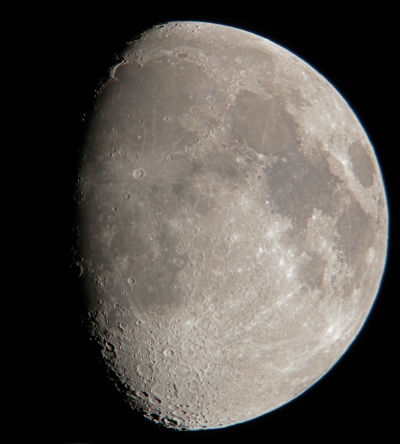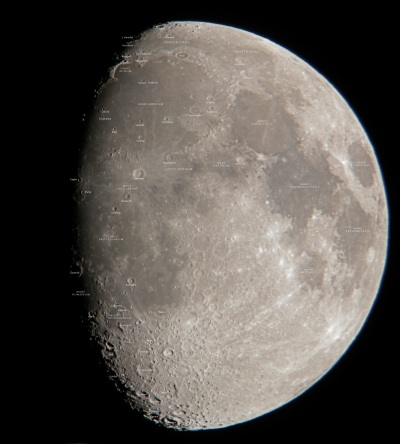A couple of craters near the terminator are coming into view tonight: Kepler and Gassendi, and at long last we get to see the beautiful bay of rainbows, Sinus Iridum. You can also see the rays from Tycho (bottom middle) and Copernicus (middle left) reaching out as if to embrace the visible surface of the moon; in a few more days these ray systems will be by far the most prominent sights on the moon. For tonight, though, we can still explore some of the intriguingly lit craters near the terminator line.
Kepler, named after the greatest computational astronomer before (and maybe since!) Newton, is a fresh crater that has a bright ray system when the sun is higher, but tonight it’s only partly illuminated, with a deep shadow still in the interior. Nevertheless, you can see the ray system starting to light up to the east. Look for it in the northern half of Oceanus Procellarum (actually, Mare Insularum, but the boundaries of Insularum and Procellarum appear arbitrary at best), at about the same latitude as the prominent crater Copernicus, which lies to its east. In fact, because of Kepler’s ray system and age, Charles Wood calls this crater “a miniature Copernicus” (172).
Gassendi, on the northern edge of the Mare Humorum, is another story entirely. Although only its outer rim is illuminated tonight, you can already see that this might be a very special crater indeed. In his investigation into this large crater, Wood quotes the description in Thomas Gwyn Elger‘s 1895 The Moon: A full Description and Map of its Principal Physical Features:
one of the the most beautiful telescopic objects on the moon’s visible surface, and structurally one of the most interesting and suggestive.
It’s not obvious from this photo, but the entire crater seems to be “tilted” to the south, toward the Mare Humorum. And it even looks like there’s a gap in the rim wall where lava from that sea might have flooded the crater, accounting for its unusually shallow depth 92.8 km) for its diameter (110 km). According to Wood, though, this is not what happened; apparently the process of this crater’s formation led to its becoming a “floor-fractured crater” (FFC). Unlike a typical FFC, though, the floor is actually uplifted, and more so on the southern end than the northern end, which is why the rim wall looks so puny on that southern end: the floor rose up to meet it!
Sinus Iridum needs no explanation, really. Just look at the most prominent feature near the terminator on the “top” (north) of the moon. Yup, you found it. Actually, though, it could stand some explanation: this is a 260-km-diameter crater that just happens to be missing half its rim wall, which appears to have slumped into the Mare Imbrium’s lava to the southeast. Wood questions whether this explains the entire phenomenon, though. You can read about, if you like, on pages 36 and 37 of his Modern Moon.
Here is tonight’s shot:
And here is the annotated version:
Tonight I finally realized what I’ve been doing wrong this whole time. I don’t have a shutter release cable, so I was just pushing the shutter button and assuming the “point-and-shoot wait” would dampen out any vibrations from my finger pushing the button. Wrong! Tonight, with the moon almost directly overhead, I had to crank the tripod up almost all the way to be able to see through the viewfinder, so the setup was at its shakiest. I was satisfied with my focus, but when I came inside to process the images, I noticed that they were all too blurry. So I went outside determined to do better, and quickly isolated the problem. Then I realized that I have a self-timer function that I can set for 3 seconds—almost exactly the amount of time it takes for this mounting system to dampen down. Huzzah!




1 thought on “January 2010 Moon, Day 10”